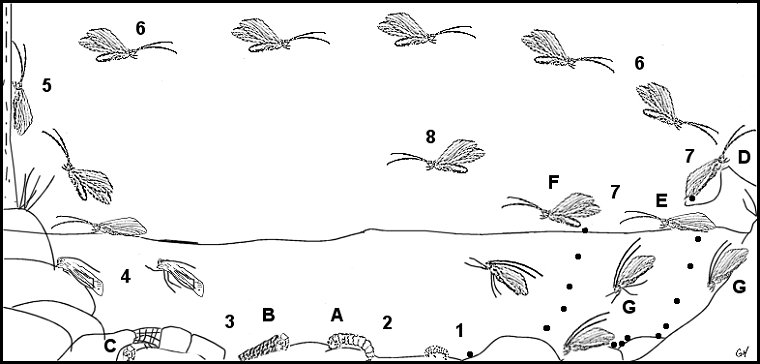
Caddisfly Life Cycle

Caddisflies demonstrate a complete lifecycle, because they undergo metamorphosis.
1. Egg matures into larva.
2. The larva lives on the bottom growing in stages called instars* (typically five) until it matures. Some
types of caddis like Rhyacophila are free living, and don't build cases until the pupal stage, other free
living caddis like Hydropsychidae build retreats near their catch nets. Others build portable cases, and
abandon them, building new ones as they grow.
A. A free living caddis.
B. Caddis larva with a portable case.
C. A free living caddis in it's retreat near it's catch net.
3. The larva then either seals it's case, or retreat, or builds a case where it pupates (undergoes metamorphosis).
4. The mature pupa cuts itself free from it's case and swims or crawls to the surface, where it sheds it's pupal membrane, and emerges as an adult.
5. The adult caddis flies into the trees, and bushes along the stream where it stays for two or three days.
Mating takes place either on the ground or in the trees, and vegetation along the stream. Mating gets underway as adults begin swarming in, and around a tree, or bush. This activity signals the beginning of the mating swarm, with the adult caddis using the bush, or tree as a landmark, or focal point to gather.
6. Females fly off to deposit their eggs.
7. Methods of egg laying (ovipositing).
D. On bushes and trees overhanging the stream, where rain will wash the eggs into the water.
E. On the stream surface.
F. Above the stream surface.
G. Swimming or crawling to the stream bottom.
8. Unlike Mayflies after ovipositing adult Caddisflies don't die right away, but fly off to live for a varying length of time.
*As invertebrates grow they shed their exoskeleton numerous times these periods of growth are called instars.